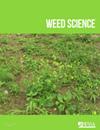美国中西部玉米-大豆轮作中抗除草剂水麻(Amaranthus tuberculatus)管理的多策略策略
IF 2.1
2区 农林科学
Q2 AGRONOMY
引用次数: 2
摘要
摘要:在爱荷华州的两个地点进行了为期2年(2019年至2020年)的田间试验,以评估在玉米(Zea mays L.)-大豆(Glycine max(L.)Merr.]轮作中管理多重抗除草剂(MHR)西瓜(Amaranthus tuberculatus(Moq.)Sauer])的多策略策略。在玉米中测试了三种除草剂方案对结核分枝杆菌控制的效果(2019)。在大豆中测试了前一年玉米杂草控制、谷类黑麦(Secale cereale L.)覆盖作物和大豆行距(38厘米对76厘米宽)对结核分枝杆菌密度、生物量和种子产量的影响(2020)。在具有两个作用位点的玉米中使用的除草剂方案对结核分枝杆菌MHR的控制率仅为35%,而具有三个作用点的除草剂方案的控制率≥97%。在大豆中,在前一年的玉米作物中充分控制结核分枝杆菌(≥90%),并使用覆盖作物或窄行作物,与前一年玉米和无覆盖作物的不充分控制(30%)相比,在种植后3周和9周(WAP),结核分枝杆菌密度降低了60%以上。与无覆盖作物和宽行大豆相比,覆盖作物和窄行大豆在3 WAP时使结核分枝杆菌密度降低了44%。与前一年玉米、无覆盖作物和宽行大豆的不充分控制(30%)相比,采用单一控制策略、在前一年的玉米中使用多种除草剂进行充分控制(≥90%)、使用覆盖作物或窄行大豆使结核分枝杆菌的生物量和大豆收获时的种子产量减少了至少24%。三种控制策略的结合使大豆收获时结核分枝杆菌的生物量和种子产量减少了至少80%。总之,在多个生命周期阶段针对结核分枝杆菌的多种控制策略可以对MHR种群的管理做出重大贡献。本文章由计算机程序翻译,如有差异,请以英文原文为准。
Multi-Tactic Strategies to Manage Herbicide-Resistant Waterhemp (Amaranthus tuberculatus) in Corn–Soybean Rotations of the U.S. Midwest
Abstract Field experiments were conducted over 2 yr (2019 to 2020) at two locations in Iowa to evaluate multi-tactic strategies for managing multiple herbicide–resistant (MHR) waterhemp [Amaranthus tuberculatus (Moq.) Sauer] in a corn (Zea mays L.)–soybean [Glycine max (L.) Merr.] rotation. The effect of three herbicide programs on A. tuberculatus control was tested in corn (2019). The effects of the prior year's corn weed control, a cereal rye (Secale cereale L.) cover crop, and soybean row spacing (38-cm vs. 76-cm wide) on A. tuberculatus density, biomass, and seed production were tested in soybean (2020). A herbicide program used in corn with two sites of action provided only 35% control of MHR A. tuberculatus compared with ≥97% control by a herbicide program with three sites of action. In soybean, adequate control of A. tuberculatus (≥90%) in the prior year's corn crop and use of a cover crop or narrow rows reduced A. tuberculatus density by more than 60% at 3 and 9 wk after planting (WAP) compared with inadequate control (30%) in the prior year's corn and no cover crop. Cover crop and narrow-row soybean reduced A. tuberculatus density by 44% at 3 WAP compared with no cover crop and wide-row soybean. Inclusion of a single control tactic, adequate control (≥90%) with multiple herbicides in the prior year's corn, use of a cover crop, or narrow-row soybean reduced A. tuberculatus biomass and seed production at soybean harvest by at least 24% compared with inadequate control (30%) in the prior year's corn, no cover crop, and wide-row soybean. The combination of all three control tactics reduced A. tuberculatus biomass and seed production at soybean harvest by at least 80%. In conclusion, diverse control tactics targeting A. tuberculatus at multiple life-cycle stages can make substantial contributions to the management of MHR populations.
求助全文
通过发布文献求助,成功后即可免费获取论文全文。
去求助
来源期刊

Weed Science
农林科学-农艺学
CiteScore
4.60
自引率
12.00%
发文量
64
审稿时长
12-24 weeks
期刊介绍:
Weed Science publishes original research and scholarship in the form of peer-reviewed articles focused on fundamental research directly related to all aspects of weed science in agricultural systems. Topics for Weed Science include:
- the biology and ecology of weeds in agricultural, forestry, aquatic, turf, recreational, rights-of-way and other settings, genetics of weeds
- herbicide resistance, chemistry, biochemistry, physiology and molecular action of herbicides and plant growth regulators used to manage undesirable vegetation
- ecology of cropping and other agricultural systems as they relate to weed management
- biological and ecological aspects of weed control tools including biological agents, and herbicide resistant crops
- effect of weed management on soil, air and water.
 求助内容:
求助内容: 应助结果提醒方式:
应助结果提醒方式:


